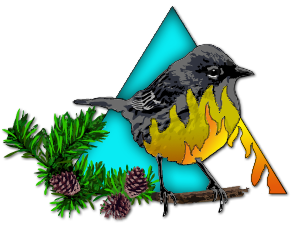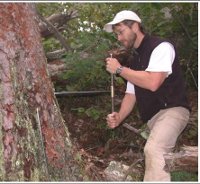Navigation

Upcoming Events
There are no events planned.
Webinar Archive
Dynamic disturbance interactions in the Border Lakes Region: A model landscape for investigating, understanding, and anticipating changing forest environments
Douglas J. Shinneman, PhD
Supervisory Research Fire Ecologist, USGS
Forest and Rangeland Ecosystem Science Center
Snake River Field Station
Webinar presented Thursday, January 17, 2013.
Click here (or paste the link http://www.youtube.com/watch?v=vm1zcstHk_g into your browser) to view the recorded webinar.
Click here (or paste the link https://osu.box.com/DynamicDisturbance into your browser) to download the entire presentation file (87.2 MB).
The relatively intact northern-mixed forest and southern boreal forest ecosystems of the Border Lakes Region (BLR) cover millions of hectares in northern Minnesota and northwestern Ontario, and the region is considered to be a landscape of international ecological significance. Although the BLR is mostly publicly owned, there is a complex pattern of ownership and management consisting of federal, state, provincial, local government, tribal, and private lands that can complicate forest and fire management. Forest composition and landscape structure within the region were historically shaped by a natural disturbance regime characterized by both stand-replacing and relatively frequent low-severity fires, as well as other disturbance agents, including windthrow and insect outbreaks. Today, much of the region’s forest composition and structure are considered highly altered following more than a century of timber harvest and past fire suppression. Forest and fire management that varies among land owners, as well as climate change and other anthropogenic influences, are expected to further impact disturbance regimes and forest communities in the BLR. In this presentation, I will highlight recent modeling and field-based research to address two key management issues facing the BLR in the near future, including: 1) How might historical natural disturbance regimes be used to guide forest restoration and fire management? 2) How might alternative management options affect future forest landscape conditions, including forest composition, structure, and disturbance effects over time? Addressing these questions not only provides opportunities for assessing and anticipating the changing landscapes of the BLR, but also informs similar forest and fire management issues in other regions.
Read more about Dr. Shinneman's work with fire regimes and forest dynamics and the USGS Snake River Field Station.
Related Publications:
Shinneman, D.J., B.J. Palik, and M.W. Cornett. 2012. Can landscape-level ecological restoration influence fire risk? A spatially-explicit assessment of a northern temperate-southern boreal forest landscape. Forest Ecology and Management 274: 126-135.
Sturtevant, B.R., B.R. Miranda, D.J. Shinneman, E.J. Gustafson, and P.T. Wolter. 2012. Comparing modern and presettlement forest dynamics of a subboreal wilderness - Does spruce budworm enhance fire risk? Ecological Applications 22:1278-1296. [Highlight]
Bradford, J. B., S. Fraver, A. Milo, A.W. D’Amato, B. Palik, and D.J. Shinneman. 2012. Effects of multiple interacting disturbances and salvage logging on forest carbon stocks. Forest Ecology and Management 267:209-214. [Highlight] [Full Text]
Fraver, S., T. Jain, J.B. Bradford, A.W. D’Amato, D. Kastendick, B. Palik, D. Shinneman, and J. Stanovick. 2011. The efficacy of salvage logging in reducing subsequent fire severity in conifer-dominated forests of Minnesota, USA. Ecological Applications 21:1895-1901. [Full Text]
Shinneman, D.J., M.W. Cornett, and B.J. Palik. 2010. Simulating restoration strategies for a southern boreal forest landscape with complex land ownership patterns. Forest Ecology and Management 259:446-458.
Bauer, M., B. Loeffelholz, and D. Shinneman. 2009. Border Lakes land-cover classification. Research Map NRS-1. U.S. Department of Agriculture, Forest Service, Northern Research Station, Newtown Square, PA. 14 p. [DVD, 14 page report, and printed map included].
Presenter Contact Information:
Douglas J. Shinneman, PhD
USGS Forest and Rangeland Ecosystem Science Center
970 Lusk Street
Boise, ID 83706
208-426-5206
email
Test your connection before the webinar:
1. To Test your computer internet connection and compatibility with adobe connect, click here (or paste http://admin.adobeconnect.com/common/help/en/support/meeting_test.htm into your brower ) and follow the prompts. You will need the browser add-in only if you anticipate speaking during the webinar.
2. You will need to use the speaker output from your computer, so make sure you know how to control your speaker volume and attach external speakers for better performance. We will prompt you to type questions in throughout the session.
3. For more information about participating in an adobe connect session, watch this 2 minute video (http://www.adobe.com/go/lrvid_cnn_803_en) or download this document.
Adobe Connect Apps for Tablets and Smartphones:
Apple iOS: https://itunes.apple.com/us/app/adobe-connect-mobile-for-ios/id430437503?mt=8
Android: https://play.google.com/store/apps/details?id=air.com.adobe.connectpro&hl=en

.png)

